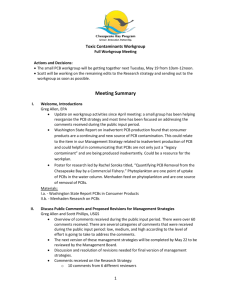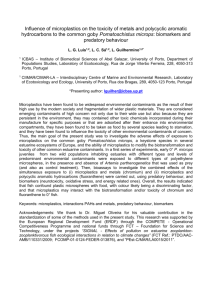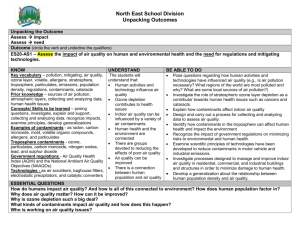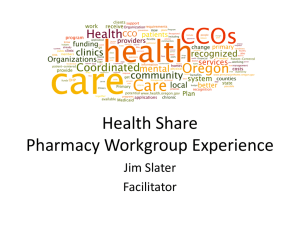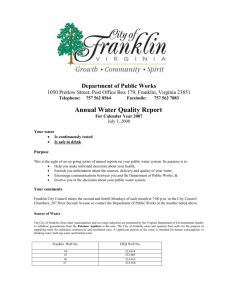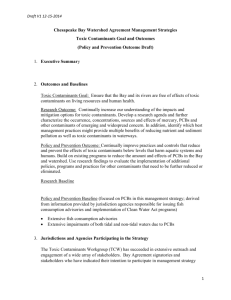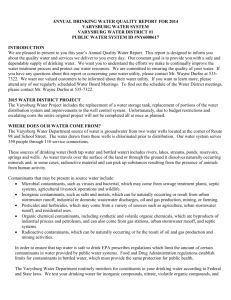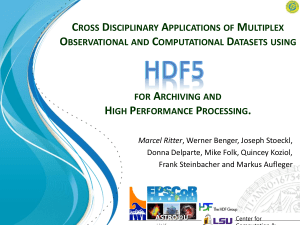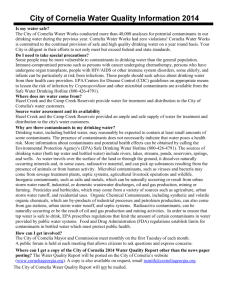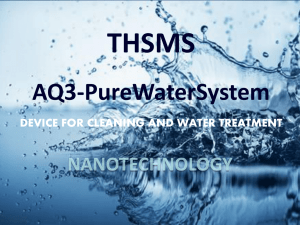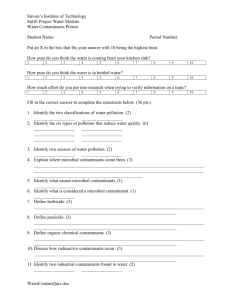Meeting Summary - Chesapeake Bay Program
advertisement
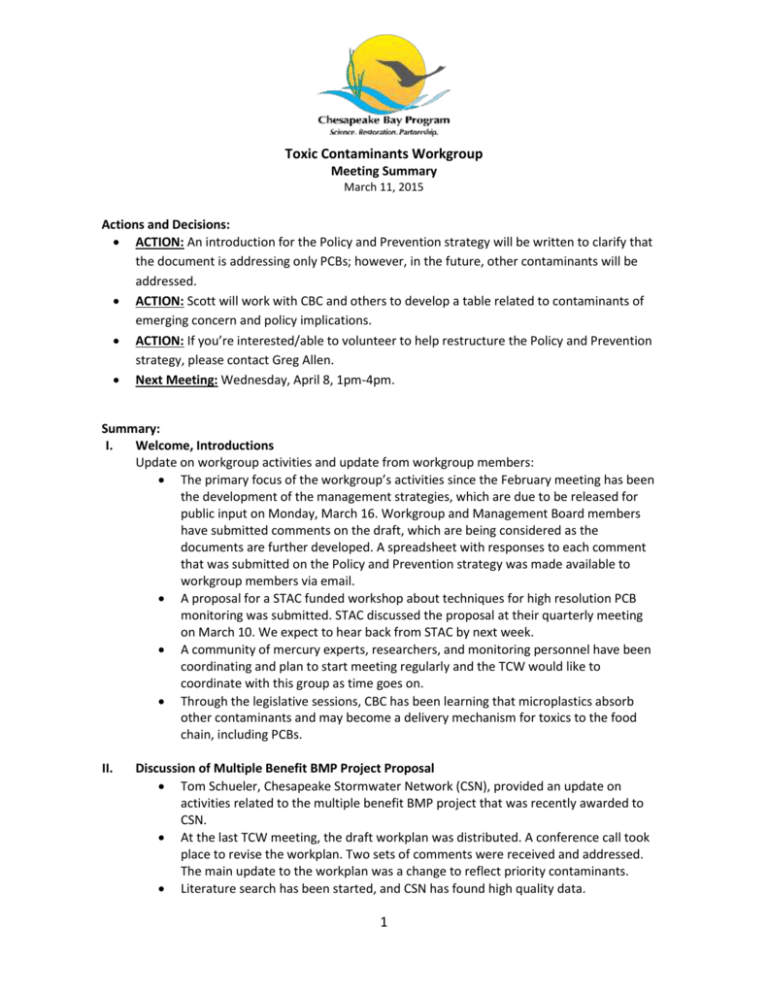
Toxic Contaminants Workgroup Meeting Summary March 11, 2015 Actions and Decisions: ACTION: An introduction for the Policy and Prevention strategy will be written to clarify that the document is addressing only PCBs; however, in the future, other contaminants will be addressed. ACTION: Scott will work with CBC and others to develop a table related to contaminants of emerging concern and policy implications. ACTION: If you’re interested/able to volunteer to help restructure the Policy and Prevention strategy, please contact Greg Allen. Next Meeting: Wednesday, April 8, 1pm-4pm. Summary: I. Welcome, Introductions Update on workgroup activities and update from workgroup members: The primary focus of the workgroup’s activities since the February meeting has been the development of the management strategies, which are due to be released for public input on Monday, March 16. Workgroup and Management Board members have submitted comments on the draft, which are being considered as the documents are further developed. A spreadsheet with responses to each comment that was submitted on the Policy and Prevention strategy was made available to workgroup members via email. A proposal for a STAC funded workshop about techniques for high resolution PCB monitoring was submitted. STAC discussed the proposal at their quarterly meeting on March 10. We expect to hear back from STAC by next week. A community of mercury experts, researchers, and monitoring personnel have been coordinating and plan to start meeting regularly and the TCW would like to coordinate with this group as time goes on. Through the legislative sessions, CBC has been learning that microplastics absorb other contaminants and may become a delivery mechanism for toxics to the food chain, including PCBs. II. Discussion of Multiple Benefit BMP Project Proposal Tom Schueler, Chesapeake Stormwater Network (CSN), provided an update on activities related to the multiple benefit BMP project that was recently awarded to CSN. At the last TCW meeting, the draft workplan was distributed. A conference call took place to revise the workplan. Two sets of comments were received and addressed. The main update to the workplan was a change to reflect priority contaminants. Literature search has been started, and CSN has found high quality data. 1 The project will likely be completed by November 2015 and with a report due to the leadership of TCW in early spring 2015. TCW members provided CSN with feedback on the proposed work for this project. The TCW requested an opportunity to comment on the method developed under Task 3 for estimating BMP efficiencies based on chemical and physical properties of contamiants prior to the start of the task 3. Tom will come back to TCW to update when applicable. III. Research Draft Strategy Review Scott Phillips led the workgroup through the major fatal flaw issues that were submitted by workgroup members and Management Board. Thank you to all workgroup members who provided comments on the draft management strategy. TCW members will have another chance to comment on the strategy during the public input period. Fatal flaw comments were received from MB earlier this week. There were three fatal flaws: o Fish mortality was misspelled as “morality.” This change will be made to the document. o The annual reporting requirement is burdensome reporting process we must do and it is not going to change much from year to year. Remediating toxics is going to be a long slow process. Monitoring will build off of the 2 year 305(b) reports to tie into the reporting that jurisdictions are already doing for other water quality standards. o PA DEP is opposed to development of a PCB model and does not want to support it. Alternative language will be developed so that the strategy doesn’t imply that a model is a definite management action. Language will include the option for the TCW to determine if a model is necessary. Other major comments received include: o There were several comments that were submitted by the Office of Management and Budget (OMB). Their concern was related to the list of endocrine disruptors and suggest that we add “potential endocrine disruptors.” We will change the language to: “known and potential endocrine disruptors.” o Neonicotinoids are not definitely connected to Colony Collapse Disorder of honeybees. The language will be toned down to deemphasize the strict linkage between neonicotinoids and CCD. IV. Policy and Prevention Draft Strategy Review Greg Allen led the workgroup through the major fatal flaw issue that were submitted by workgroup and Management Board members. Themes of fatal flaw issues include: NPDES stormwater permit limits, NPDES stormwater monitoring, overall organization of the document, assessing progress, and model development. 2 V. Greg proposed updates to the document to address these issues. The workgroup agreed to all of the proposed changes. These changes are summarized in the document “List of Key Issues with Workgroup Edits” and will be reflected in the management strategy document. ACTION: An introduction will be written to clarify that the document is addressing only PCBs; however, in the future, other contaminants will be addressed. CBC has found research that shows microplastics are a delivery mechanism for PCBs and other contaminants and feels that this should be included in the factors influencing section. Additionally, this could also be included in the wastewater section because the source mechanism for microplastics they are primarily found in personal care products which go into wastewater. o Upal Ghosh: Research indicates that the proportion of PCBs delivered by microplastics compared to other mechanisms is very small and might not be necessary to be addressed. The majority of microplastics are picked up in the settling tanks. o Jennie Gundersen: Some microplastics don’t settle and do stay in the water column. o Microplastics will be included in the research strategy because it is not a major element for PCBs. Scott will work with CBC to enhance the language. Discussion on how/when to reflect ongoing work on other contaminants. One option is to start to describe other contaminants and valuable work that is underway in this version of the strategy although that may be difficult due to time constraints. A second option is to include a statement in the “Management Approaches” section of the strategy saying the TCW will begin to document current efforts and gaps for other contaminants as part of the two-year workplan. ACTION: Scott will work with CBC and others to develop a table related to contaminants of emerging concern and policy implications. ACTION: If you’re interested/able to volunteer to help restructure the Policy and Prevention strategy, please contact Greg Allen. Discussion of Next Steps and Management Strategy Deadlines March 6 - MB deadline for submitting fatal flaw comments to GITs/workgroups. March 12: MB discussion of any issues that still need to be resolved Mar. 16 - Post/release revised management strategies public input. Apr. 8 - Toxic Contaminants Workgroup meeting. Apr. 20 - Public input period closes. (subject to change based on PSC decision on public comment period extension) Apr. 30 - Potential public input period closes. May 4 - GITs/workgroups revise strategies and provide to MB for final review. This date may be changed to the middle of May, pending a MB decision to be made on 312-15. June 15 - Final management strategies completed. Dec. 15 - First Biennial workplan due. Next meeting: April 8, 1-4pm. Attendance: Len Schugam, MDE Dinorah Dalmasy, MDE 3 John Sherwell, MD DNR Bruce Michael, MD DNR Mark Richards, VA DEQ Don Smith, VA DEQ George Onyullo, DDOE Rod Kime, PA DEP Tom Barron, PA DEP John Schneider, DNREC Marel King, CBC Dave Montali, WV DEP Scott Phillips, USGS Greg Allen, EPA CBPO Jennie Gundersen, EPA CBPO Angie Garcia, EPA R3 WPD Lorie Baker, EPA R3 HSCD Robin Eisemann, EPA R3 Regional Council Fred Pinkney, FWS Ian Hartwell, NOAA Molly Clark, CBF Lindsay Dodd, DE MD Agribusiness Dan Smith, Anacostia Watershed Society LJ Ingram, Chart, LLC Nick Corso, AXYS Analytical Jamie Mitchell, HRSC Tom Schuler, CSN Samantha Watterson, CRC Upal Ghosh, UMBC Nick Corso, Contech Joshua Rodriguez, DDOE Ann Swanson, CBC Sherm Garrison, MD DNR Cathleen Van Osten, EPA R3 Dianne McNally, EPA R3 WPD Dottie Yunger, National Church 4
